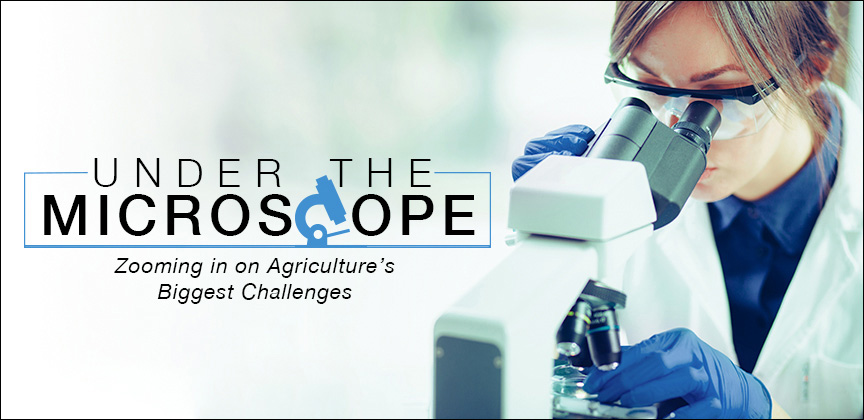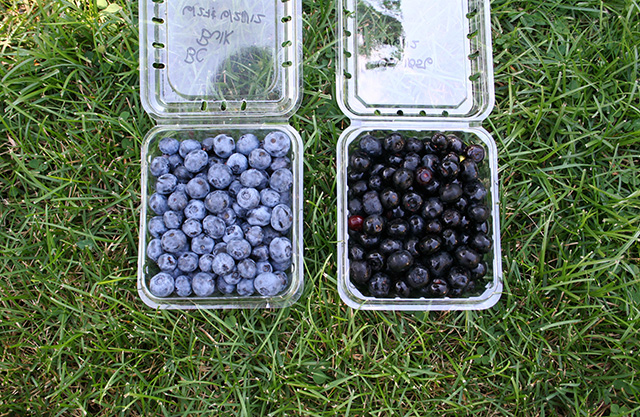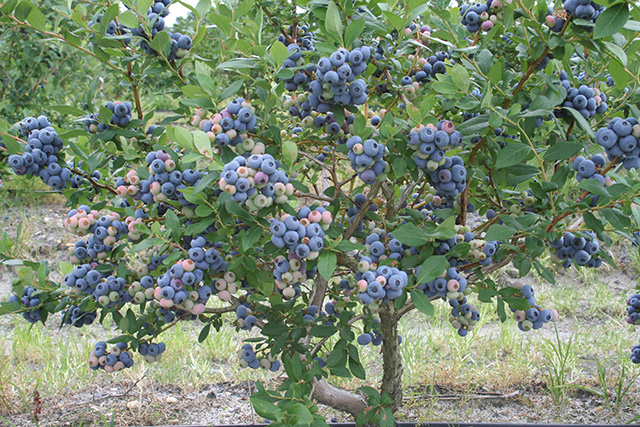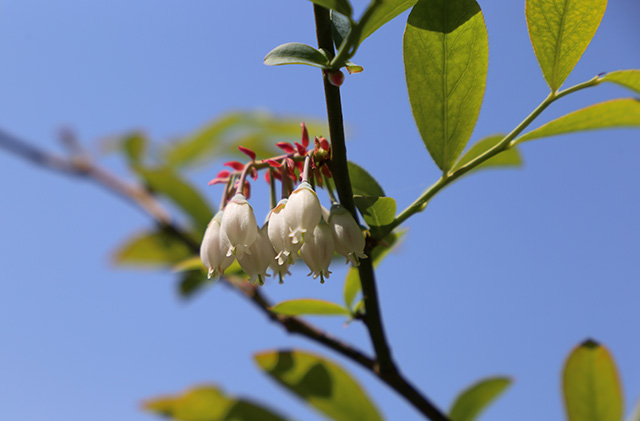Breeding Better Blueberries : USDA ARS (original) (raw)

|  | | Drs. Jim Polashock and Jeannie Rowland are researchers with the Genetic Improvement for Fruits & Vegetables Laboratory located in Beltsville, MD. Their work involves the improvement of blueberries through the identification and evaluation of genetic markers linked to traits like fruit color, cold hardiness, and disease resistance. |
| ------------------------------------------------------------------------------------------------------------------- | | -------------------------------------------------------------------------------------------------------------------------------------------------------------------------------------------------------------------------------------------------------------------------------------------------------------------------------------------------------------------------------------------------------------------------------------------------------------------------------- |
| | Drs. Jim Polashock and Jeannie Rowland are researchers with the Genetic Improvement for Fruits & Vegetables Laboratory located in Beltsville, MD. Their work involves the improvement of blueberries through the identification and evaluation of genetic markers linked to traits like fruit color, cold hardiness, and disease resistance. |
| ------------------------------------------------------------------------------------------------------------------- | | -------------------------------------------------------------------------------------------------------------------------------------------------------------------------------------------------------------------------------------------------------------------------------------------------------------------------------------------------------------------------------------------------------------------------------------------------------------------------------- |
Welcome Drs. Polashock and Rowland to Under the Microscope.
UM – Why are blueberries blue?
JP & JR – Blueberries carry pigments, called anthocyanins, in their skins. These compounds give blueberries their characteristic color.
UM – Blueberries are often hailed as ‘superfruits.’ What makes these berries so healthy?
JR – The same compounds that give blueberries their hue are also potent antioxidants. Anthocyanins have been linked to many health benefits, from improving night vision and preventing macular degeneration to ameliorating inflammation associated with chronic diseases like cancer and heart disease.
JP – In addition to the anthocyanins, blueberries are relatively low in calories and packed with other nutrients including vitamin C, potassium, and compounds called flavonoids. The flavonoids also have been linked to anti-inflammatory activity.
 Side by side comparison of two blueberry lines; ‘Bluecrop’ (left) has light blue-colored fruit with a waxy coating, while ‘Nocturne’ has black-colored fruit without a waxy coating. (Photo courtesy of Mark Ehlenfeldt, ARS)
Side by side comparison of two blueberry lines; ‘Bluecrop’ (left) has light blue-colored fruit with a waxy coating, while ‘Nocturne’ has black-colored fruit without a waxy coating. (Photo courtesy of Mark Ehlenfeldt, ARS)
UM – Which blueberry traits are you and your team looking to improve?
JR – We focus on improving traits that are important to the blueberry industry. For example, we hope to discover the genes that are responsible for climatic adaptation (like cold hardiness and chilling requirement), which help determine the geographical range where plants can be grown. We’re also studying several fruit quality traits, such as firmness and scar size. The scar is the opening on the back of the berry that is left when the stem detaches. This can be an entry point for diseases, so it is important that the opening is small.
Fruit color is also an important trait that we are researching. Berries can range from black to the more desirable light blue color. The light blue color is the result of a waxy coating on the fruit that can help prevent disease and desiccation (the drying out of the fruit).
JP – Another one of our goals is to improve natural disease resistance in blueberries. We are working on uncovering the genes associated with disease resistance. Once discovered, we can bring resistance genes from various blueberry plants into superior plants through traditional breeding. Blueberries with improved resistance reduce production costs and help protect the environment and consumers. We are also working on varieties suitable for machine harvesting, which requires the fruit to be firm and ripen around the same time. Machine harvesting increases sustainability by reducing costs.
 Blueberry plants of a new ARS-developed cultivar ‘Talisman.’ (Photo courtesy of Mark Ehlenfeldt, ARS)
Blueberry plants of a new ARS-developed cultivar ‘Talisman.’ (Photo courtesy of Mark Ehlenfeldt, ARS)
UM – The U.S. blueberry crop alone is estimated to be worth more than $900 million and the global blueberry market is swiftly expanding. What kinds of threats do blueberry growers and producers currently face?
JP – To be competitive, growers must produce a quality product while keeping costs down. This involves research across several different disciplines including breeders, horticulturalists, pathologists, and others that all contribute to various aspects of developing improved varieties, disease control and production practices.
JR: In some years, severe low temperatures in winter can cause damage to flower buds. Also, frosts in late winter and early spring can cause major damage to opening flowers in some years. This kind of damage to flower buds and opening flowers decreases fruit yield.
UM – What common pathogens or fungi should home gardeners be aware of?
JP – Since blueberries are native to North America, they are well-adapted to grow here and have few important disease problems. However, the most common disease home gardeners are likely to see is fruit rot — called anthracnose — that is caused by a fungus. While not harmful to consume, it can make the berries soft and unappealing. Another common fungus-caused threat to blueberries is a disease called mummy berry, which results in leaf infections and small dried fruit called ‘mummies.’
Blueberries can also acquire viral infections that reduce plant vigor and yield. Unfortunately, virus-infected blueberries cannot be cured and affected bushes must be removed to contain the virus. In addition, most of these viruses are transmitted by sucking insects, so the best way to prevent blueberry viruses from spreading is through insect control.
 A blueberry plant in bloom. The blueberry’s flowering period is critical for pollination. (Photo courtesy of Elizabeth Ogden, ARS)
A blueberry plant in bloom. The blueberry’s flowering period is critical for pollination. (Photo courtesy of Elizabeth Ogden, ARS)
UM – How can growers protect their blueberries?
JP – Home gardeners should check with their local gardening supply store for recommendations on how to control the diseases and insects. Birds eating the berries as they ripen is probably more of issue for home gardeners. Bird netting can be purchased at gardening supply stores to help protect the crop.
UM – How can consumers extend the shelf life of blueberries?
JP – Fresh blueberries generally disappear pretty quickly but keeping them in the refrigerator will help extend shelf life. They can also be frozen for longer term storage.
UM – Do blueberries lose some of their nutritional value if frozen or mixed with other fruits?
JP – Blueberries maintain all of their nutritional quality after being frozen. In fact, freezing can help preserve some nutrients. The berries will be soft when they defrost but will still taste great.
UM – Can your research in blueberry improvement be applied to other fruits, such as other members of the genus Vaccinium like cranberries?
JP – Blueberries and cranberries are actually closely related North American fruit crops. Although they appear to be quite different, as blueberries grow on bushes with soft sweet fruit while cranberries grow on low-growing vines and bear firm tart fruit, they are actually genetically quite similar.
JR – We have been working on team projects to sequence the blueberry and cranberry genomes. Due to their similarities, we can compare traits and markers of one species to those in other related species and transfer information between the two. – by Georgia Jiang, ARS Office of Communications.